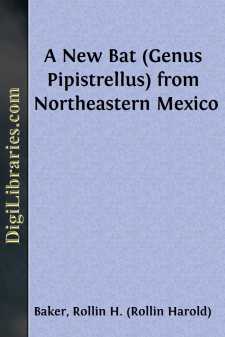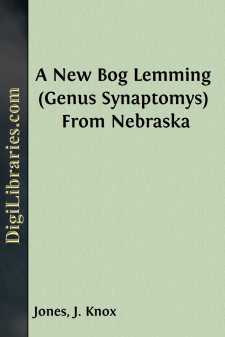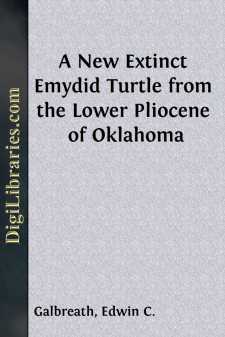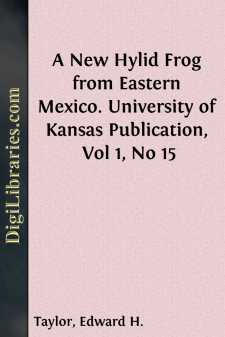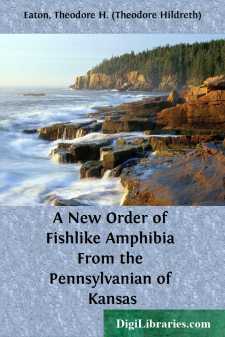Fiction
- Action & Adventure 180
- Biographical 15
- Christian 59
- Classics
- Coming of Age 5
- Contemporary Women 3
- Erotica 8
- Espionage/Intrigue 12
- Fairy Tales, Folklore & Mythology 236
- Family Life 169
- Fantasy 117
- Gay 1
- General 596
- Ghost 32
- Historical 808
- Horror 43
- Humorous 160
- Jewish 25
- Legal 4
- Medical 22
- Mystery & Detective 315
- Political 49
- Psychological 41
- Religious 64
- Romance 159
- Sagas 11
- Science Fiction 730
- Sea Stories 113
- Short Stories (single author) 537
- Sports 10
- Suspense 1
- Technological 8
- Thrillers 2
- Urban Life 31
- Visionary & Metaphysical 1
- War & Military 173
- Westerns 199
Classics Books
Sort by:
The eastern pipistrelle, Pipistrellus subflavus (Cuvier) in the western part of its range, occurs along the RÃo Grande and its tributaries as far west as northern Coahuila and Val Verde County, Texas. Specimens from those places represent a heretofore undescribed subspecies which may be named and described as follows: Type.—Female, adult, skin and skull; No. 48270, Univ. Kansas Mus. Nat. Hist.;...
more...
A single specimen of little brown bat from the northern part of the state of Veracruz seems to be of an heretofore unrecognized species. It is named and described below. Myotis elegans new species Holotype.—Female, adult, skin and skull, No. 88398 Museum of Natural History, The University of Kansas; 12-1/2 mi. N. Tihuatlán, 300 ft. elevation, Veracruz, Mexico; obtained on September 24, 1961, by...
more...
by:
J. Knox Jones
In the autumn of 1952, I obtained a southern bog lemming, Synaptomys cooperi, at Rock Creek State Fish Hatchery, Dundy County, in extreme southwestern Nebraska. This locality of record is the westernmost for the species in North America. Subsequently, I reported this specimen in the literature (Univ. Kansas Publ., Mus. Nat. Hist., 7:486, 1954), provisionally assigning it to Synaptomys cooperi gossii,...
more...
In the summer of 1946 a party from the University of Kansas Museum of Natural History visited exposures of the Laverne formation in Beaver County, Oklahoma, at the invitation of Dr. Stuart Schoff of the United States Geological Survey. When examining the marl beds an Emydid turtle was discovered which appears to be an unnamed species of the genus Chrysemys. A description of the new species follows....
more...
by:
Joan Echols
Discussion.—Because of the great differences in endocranial structure between the Devonian and Pennsylvanian coelacanths, they are here placed in new subfamilies. The two proposed subfamilies of the family Diplocercidae are the Diplocercinae and the Rhabdodermatinae. The Diplocercinae include those coelacanths having two large unpaired bones in the endocranium (at present this includes Diplocercides...
more...
by:
Edward H. Taylor
A small collection of Mexican reptiles and amphibians recently acquired by the University of Kansas Natural History Museum contains five specimens of a species of the genus Hyla (sensu lato) which is here described as new. Hyla proboscidea sp. nov. Type.—University of Kansas Museum of Natural History, No. 23626, collected 2 km. west of Jico, Veracruz, Mexico, at an elevation of 4,200 ft., Oct. 28,...
more...
Long-eared bats obtained by field parties from the University of Kansas in the Mexican states of Coahuila, Nuevo León, and Tamaulipas, are found to belong to the species, Myotis evotis, but are not referable to any named subspecies. They are named and described as follows: Myotis evotis auriculus new subspecies Type.—Female, adult, skin and skull; No. 55110, Univ. Kansas Mus. Nat. Hist.; 10 mi. W...
more...
A slab of shale obtained in 1955 by Mr. Russell R. Camp from a Pennsylvanian lagoon-deposit in Anderson County, Kansas, has yielded in the laboratory a skeleton of the small amphibian Hesperoherpeton garnettense Peabody (1958). This skeleton provides new and surprising information not available from the holotype, No. 9976 K. U., which consisted only of a scapulocoracoid, neural arch, and rib fragment....
more...
by:
Robert B. Finley
The extensive collection of Mexican mammals made by Mr. J. R. Alcorn for the University of Kansas Museum of Natural History contains fourteen piñon mice from lava rocks eight miles northeast of the city of Durango, Mexico. These mice are all much darker than the piñon mice, Peromyscus truei gentilis, of adjoining areas in Durango and Zacatecas and show a superficial resemblance to the widespread P....
more...
Among small mammals accumulated, from Wyoming, in the Museum of Natural History of the University of Kansas, specimens of the wide-spread species Thomomys talpoides are abundantly represented. Subspecific names are available for most of these, but specimens from the Sierra Madre Mountain Range of Wyoming and Colorado prove upon comparison to pertain to an heretofore unnamed subspecies which may be...
more...


